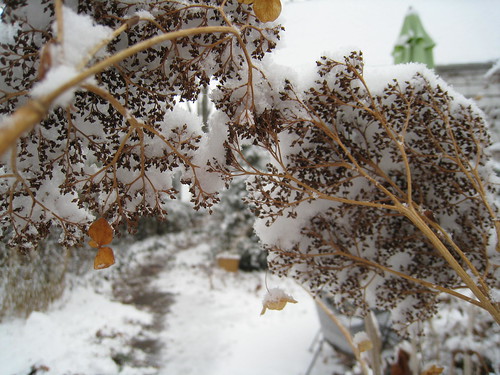 |
| Wild Hydrangea holds on to the snow. AMcC |
When no one will volunteer to crank the ice cream maker and best friends refuse to accompany each other to the latrine at night, it's time to go to Green Cathedrals. One counselor begins, saying, "On my honor, I will try." Another reads a poem about friendship. If it's the second week of the session, better sing all four verses of "Kumbyah" too--guaranteed to restore harmony in the group for a good 30 or 40 minutes.
I don't have the same karst topography in my yard, but I can still enjoy wild hydrangea. Native bees love the flowers, because, unlike many cultivated hydrangeas, the large flower heads produce lots of pollen. Surrounding the flower head are "false" or sterile flowers with three relatively large petals. They open before the "true" flowers, and are still hanging on to my plant in the above photo, adding to the charm of this shrub. Tried and True Missouri Native Plants for Your Yard (Barbara Fairchild, ed., Missouri Dept. of Conservation, 2007) recommends pruning back branches in early spring, since most of the blooms appear on new growth.
For a look at wild hydrangea through the seasons, click on one of these photos.





I love wild hydrangea in the snow - I posted a photo like this on my blog back last winter before I learned what the plant was called, and I still remember every detail of the walk on which I took the photo, in the deep stillness of a forest under snow. It's something I really miss here on the snow-less Georgia coast. Thanks for taking me back there.
ReplyDeleteAnne, way back in the dark ages, I was a 10-year old you took to Green Cathedrals. Used to be one of my favorite places... hope it has not changed; I hope even more that counselors are still taking their unruly charges up there for a Scouts' Own.
ReplyDeleteI have a soft spot for this plant too! It's amazing how things can trigger memories you didn't realize you had.
ReplyDeleteHey Laura! Of course, you were always good about cranking the ice cream. The last time I was there, Green Cathedrals was as lovely as ever. Thanks for the visit and the comment!
ReplyDeleteThe one I bought at the spring wildflower sale at Shaw Nature Reserve in 2009 languished in a pot until this fall, when it finally went in the ground. Am looking forward to seeing how it does this spring.
ReplyDeleteHopefully, a plant that can squeeze between limestone ledges can survive in a small pot. I hope it really takes off in a few months!
ReplyDeleteGreen Cathedrals was such a special place. You could walk into it from the hot fields below and find a cool calmness that was amazing! It was truly a place to reflect, regain composure, strength and get the Girl Scout message across! Thanks for sharing Anne!
ReplyDeleteThere are times when we all need a little shade and greenery. And "Kumbyah" never hurts either! Thanks for the comment, Julia!
ReplyDeleteWild hydrangea in flower is incredibly attractive to longhorned beetles - including some quite uncommon species. You should keep an eye out for them during the late June/early July bloom period.
ReplyDeleteI'll definitely look for them. I hope they look like your photo of the elderberry borer.
ReplyDelete